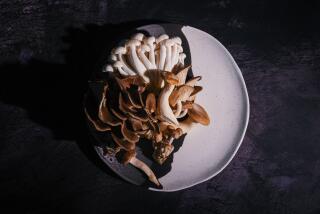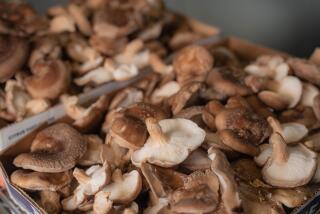Aristocrats of the Mushroom Kingdom : Fungi: Scandinavians call morels the ‘truffles of the north,’ but they grow in temperate zones throughout the world.
- Share via
With most people, certain foods are inextricably linked to the time and place they first tasted them. So it is with me and the wild mushroom known as the morel. After college, I spent several months in Paris. My apartment bordered the Rue Cler, one of the city’s most colorful street markets, where I experienced this distinctive mushroom for the first time.
It was early May. My greengrocer led me excitedly to a small pile of dark, cone-shaped mushrooms, the first of the season’s morels. I was instantly drawn to these fungi, their elongated stems like one of Modigliani’s beauties, their caps indented like honeycomb.
Gathering up hoarded sous, I purchased a dozen of the morels--a splurge for someone on a student budget. At the vendor’s advice, I sauteed them with garlic and butter over the hot plate in my room. I was beguiled by their haunting, smoky, buttery flavor. The ridged surface tickled my tongue. It was love at first bite.
I recently feasted on morels at the home of Amy and Thierry Farges in New York. The Farges are the owners of Aux Delices des Bois (The Delicacies of the Woods), a company that distributes exotic mushrooms. They receive their mushrooms from fungus hunters throughout Europe and North America. Interestingly, most of their morels come not from Thierry’s native France but from the Pacific Northwest. And this time of year, the morel business is, well, mushrooming.
Morels are the aristocrats of the mushroom kingdom. Scandinavians call them the “truffles of the north.” Mycologists affectionately refer to them as “Helens”--a reference to the beauty of Helen of Troy. In China, they are known as “sheeps’ stomachs,” an apt description of the tripe-like indentations in the cap. Appropriately, the Chinese eat morels as a remedy for stomach illness.
In bygone centuries, whole sections of Germany’s Black Forest were burned down by morel enthusiasts, who believed that the mushroom prospered in ashy soil. (Morels do, indeed, flourish on land ravaged by forest fires.) Laws had to be enacted to protect the forests where these honeycombed fungi grew.
Actually, morels grow in temperate zones throughout the world, from Azerbaijan to Australia. The morel is the official state fungus in Minnesota. Other important sources are Michigan, Oregon and Washington state. Morels grow near birch and aspen groves, in apple and cherry orchards, in stands of bracken ferns and at the edges of conifer forests.
But despite their wide habitat, morels are relatively elusive. They appear at a specific site for only two weeks. They seldom grow in the same spot two years in a row. Morel season begins in mid-March, after the first spring rains. Peak season occurs in May and June, tapering off in August. At the height of the season, fresh morels retail for $12 to $14 a pound. Dried morels run $90 to $100 a pound and are available all year long.
There are more than 60 species of morels. Best known in this country is Morchella esculenta, a tan morel that makes its appearance in early spring. Morchella elata, the dark or black morel, is the preferred morel of Europe, possessing a stronger flavor. Black morels also grow in North America; they begin to appear in May. Their superior flavor is offset by the fact that they often contain bugs. Morels grow 2 to 6 inches high. Unlike most mushrooms, they are hollow, both the cap and stem.
When buying morels, look for firm, springy specimens free of bug holes and wilted stems. To minimize waste, choose morels with short stems. Store fresh morels in the refrigerator in a cloth bag, a loosely closed paper bag or a holed plastic container. (This enables them to “breathe,” says Farges.) Morels store well. I’ve keep fresh ones for up to a week. To store for longer periods, saute fresh morels until tender, then freeze.
To reconstitute dried morels, place them in a bowl of hot water for one hour. You can shorten the reconstituting time by using the microwave. (When soaking dried morels, the Farges like to add Madeira to the water.) One ounce of dried morels equals five ounces fresh.
Strain the reconstituted morels through a cheesecloth and wring dry, reserving the liquid for sauces or soups. (You may wish to pour the juice through a coffee filter to remove any sand or grit.) Drying intensifies the flavor of mushrooms. Some chefs use both dried and fresh morels in a single dish.
Leave small morels whole; cut large ones into halves, quarters, or--for an attractive garnish--into longitudinal slices. Large morels are great for stuffing with herbed bread crumbs, crab meat or cheese.
The basic way to cook morels is to saute them in butter with a little minced shallot or garlic for four to six minutes, or until tender. Morels go well with cream, green peppers (used sparingly), caraway seeds, chicken, steak and sweetbreads. Under no circumstances should they be eaten raw.
Morels are low in calories and high in Vitamin D. Their suggestive shape leads some people to consider them aphrodisiacs--actually a claim made for most wild mushrooms. Morels are so popular among mushroom fanciers that they are the subject of a new 80-page book, “The Morel Mushroom,” by John Ratzloff (Voyageur Press, Stillwater, Minn., 1991).
Look for fresh morels at specialty greengrocers. Dried ones can be found at gourmet shops. Or order them by mail from Aux Delices des Bois, 4 Leonard St., New York, N.Y. 10013, (212) 334-1230, fax (212) 334-1231.
FETTUCCINE WITH MOREL CREAM SAUCE
25 fresh or dried morels
5 tablespoons butter
3 shallots, minced
1 clove garlic, minced
1/4 cup Cognac
2 cups whipping cream
Freshly grated Parmigiano Reggiano cheese
Salt
Freshly ground pepper
Cayenne pepper
1 pound fresh egg fettuccine
1 teaspoon oil
3 tablespoons chopped parsley
If using fresh morels, wipe or wash as previously described. If using dried morels, soak as previously described, then strain soaking liquid and boil down until only 2 tablespoons remain. Cut morels lengthwise into quarters or halves.
Heat 3 tablespoons butter in skillet. Saute morels, shallots and garlic over medium heat 3 minutes, or until tender but not brown. Add Cognac and flambe. (If working over electric heat, boil Cognac until reduced by half.)
Stir in whipping cream (and morel soaking liquid, if using). Gently simmer mixture until reduced to about 1 cup. Whisk in remaining 2 tablespoons butter and 1/4 cup cheese. Season to taste with salt, pepper and cayenne.
Bring 4 quarts water to boil. Just before serving, cook fettuccine in rapidly boiling, lightly salted water with oil 1 to 2 minutes, or to desired doneness. Drain pasta thoroughly and toss with morel cream sauce. Serve at once, sprinkled with parsley and extra cheese. Makes 4 appetizer or 2 entree servings.
More to Read
Sign up for Essential California
The most important California stories and recommendations in your inbox every morning.
You may occasionally receive promotional content from the Los Angeles Times.












